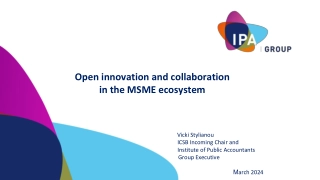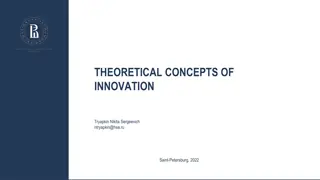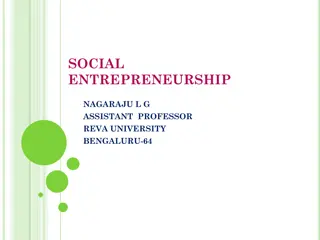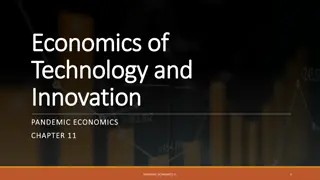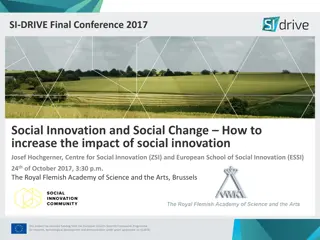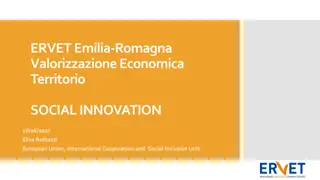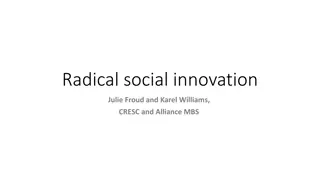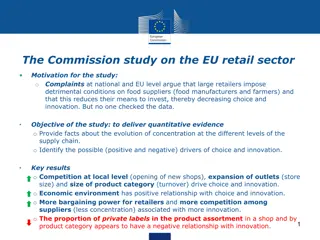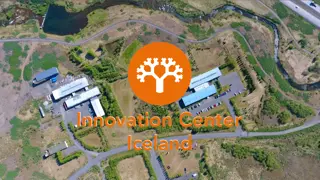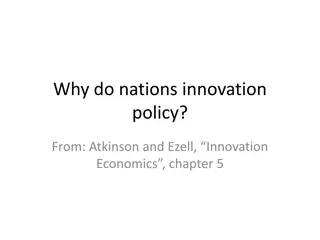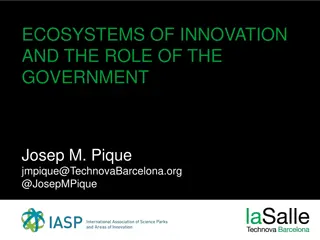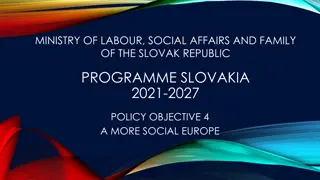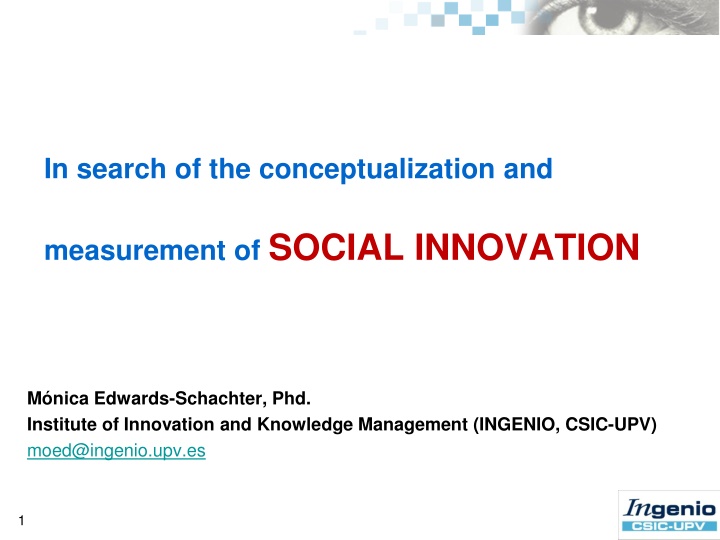
Unveiling the Essence of Social Innovation Research
Delve into the conceptualization and measurement of Social Innovation through the insightful work of Mónica Edwards-Schachter, Ph.D. Explore the evolving paradigms, challenges, and impact of Social Innovation in addressing pressing social issues and fostering sustainable systems.
Download Presentation

Please find below an Image/Link to download the presentation.
The content on the website is provided AS IS for your information and personal use only. It may not be sold, licensed, or shared on other websites without obtaining consent from the author. If you encounter any issues during the download, it is possible that the publisher has removed the file from their server.
You are allowed to download the files provided on this website for personal or commercial use, subject to the condition that they are used lawfully. All files are the property of their respective owners.
The content on the website is provided AS IS for your information and personal use only. It may not be sold, licensed, or shared on other websites without obtaining consent from the author.
E N D
Presentation Transcript
In search of the conceptualization and measurement of SOCIAL INNOVATION M nica Edwards-Schachter, Phd. Institute of Innovation and Knowledge Management (INGENIO, CSIC-UPV) moed@ingenio.upv.es 1
Keynotes Focus: What is Social Innovation (SI)? SI: An approach for a new nature (and new measurement problems) of innovation ? SI as research topic: Within or outside of the innovation studies field? Developing indicators of SI: Exploring social places and spaces Final comments 2
Focus: What is Social Innovation? SI is an outstanding paradigm that is increasingly attracting the interest of research, organizations and policy makers (Andrew & Klein, 2010; EU/The Young Foundation, 2010; Howaldt &Schwartz, 2010; Hubert, 2010) The Renewed Social Agenda (EC 2008) emphasizes the role of SI as an opportunity to address Europe s response to new social realities and promoting a better quality of life. SI is seen as a powerful instrument to address the economic crisis (and other global crisis) requiring both quick solutions to pressing social problems and the long term development of a sustainable social system (BEPA, 2009). 3
But The concept of social innovation is often used interchangeably with a number of different topics including innovation activities in the non-profit sector, social entrepreneurship, social economy, social enterprise (Moulaert et al, 2005; Mulgan et al., 2007; Rodr guez & Alvarado, 2008; Andrew & Klein, 2010; Howaldt & Shwarz, 2010). 4
The The SOCIAL side of TECHNOLOGICAL innovation? TECHNOLOGICAL side of SOCIAL innovation? DIFUSSION DIFUSSION OF INNOVATION? INNOVATION? OF SOCIAL SOCIAL IMPACT IMPACT OF INNOVATION INNOVATION? ? OF 5
SI: An approach for a new nature (and new measurement problems) of innovation ? Mulgan (2006:8) affirms that Social innovation refers to innovative activities and services that are motivated by the goal of meeting a social need and that are predominantly diffused through organizations whose primary purposes are social . Phills et al. (2008) have underlined the mechanisms involved in bringing about positive social change, bolstered by the cross- fertilization of the non-profit, government, and business sectors For MacCallum et al. (2009:1)- is an anchor concept for research in creative arts, human organization, economic diversity, neighbourhood regeneration, regional renaissance, governance and other areas . 6
SI: An approach for a new nature (and new measurement problems) of innovation ? A recent report of The Young Foundation (2010, p. 10) identifies four drivers of future innovation: 1) Co-creating value with customers and tapping knowledge about users; 2) Global knowledge sourcing and collaborative networks; 3) Global challenges as a driver of innovation; 4) Public sector challenges as a driver of innovation 7
SI: An approach for a new nature (and new measurement problems) of innovation ? In words of Howaldt and Schwarz (2010) innovations are deliberative interventions designed to initiate and establish future developments concerning technology, economics, and social practices How can people act as lead users and contribute to social innovation? How can share social innovation best practices? How to measure social innovation ? 8
SI as research topic: Within or outside the innovation field? The introduction of the social to innovation and viceversa, as well as of innovation to the social has been considered from multiple research perspectives, embracing social science and economic literatures, as well as in the socio-political practice (Brooks 1982). Brooks (1982) has analyzed the social dimensions of invention and innovation, classifying social inventions and innovations as market, managerial, political, or institutional. When distinguishing between "pure social inventions and innovations, socio-technical system innovations, and pure technical innovations" he cautions that "there are no entirely pure types" 9
Schumpeter underscores the necessity of social innovation occurring in tandem in both the economic arena as well as in culture, politics and a society's way of life in order to guarantee the economic efficacy of technical innovations (Howaldt & Schwarz , 2010: p. 9) . But However, the mention of social innovation in literature after Schumpeter is rare and only marginal and the focus is essentially in technological innovations. The presence of SI in innovation research literature is still scarce and marginal 10
Developing indicators of SI Murray et al. (2009) in their working paper How to innovate: The tools for social innovation list 260 methods, processes and examples of social innovation in their proposal of social economy framework. 11
Developing indicators of SI Indicators Measurement should capture the different aspects of the phenomena In-puts ... Needs to building social innovation capabilities ? Process ... Problems with indicators of traditional innovations (technological, in services, organizational ...) ! Out-puts... Values co-generation, quality of life, well-being improvement, ... diffusion and Impact? 12
13 EXAMPLE 1 Bringing light to the poor: A litre of light project http://isanglitrongliwanag.org/ http://www.bbc.co.uk/news/world-asia-pacific-14967535 Eco-entrepreneurs students from MIT using 2-liter soda bottles and bleach to bring a 60 watt light bulb's worth of light into the building below. A bit of brightness into the lives of the country's poorest people in the Philippines.
14 EXAMPLE 2 CVida http://www.cvida.com http://es-es.facebook.com/CvidaVilareal LOCAL COMPANIES AND AUTHORITIES CVida Vilareal is an association of multiple actors in the city of Vilareal (Castellon, Spain) . LOCAL RESOURCES Innovationopportunities Improvementopportunities Governancesupport Goals Goals The improvement of people s quality of life and the creation of employment. PEOPLE ITC PEOPLE NEEDS SYSTEM Qualityof life The city as a local social innovation space.
15 EXAMPLE 2 CVida http://www.cvida.com http://es-es.facebook.com/CvidaVilareal
FINAL COMMENTS Social Innovation is a multi-faceted concept which can be placed at the intersection of spontaneous and rationally organized movements at the micro, meso or macro levels of society (bottom-up). Further research on social innovation will be important in order to increase our understanding of the concept and theoretical interrelationships between technological, non-technological and social innovation (and the development of appropriate measurement methodologies and instruments). Part of innovation studies or a new discipline?
FINAL COMMENTS In Cvida initiative, our principal purpose is to explore the transformational potential of mechanisms of the process of collective action and urban governance practices, promoting both the intentional cross-sector fertilization and a system- building or scaffolding endeavour that accomplishes the mechanisms of social innovation. We are also exploring the development of indicators, considering in-puts, process and out-puts ...
References ANDREW, C. and KLEIN, J. L. (2010). Social Innovation: What is it and why is it important to understand it better. ET10003. Ontario Ministry of Research and Innovation. Toronto. Cahiers du Centre de recherche sur les innovations sociales (CRISBROOKS, H. (1982). ES). Collection tudes th oriques, no ET1003. BROOKS, H. (1982). Social and technological innovation. In Lundstedt, Sven B. and Colglazier, E. William, Jr. (Eds.), Managing innovation. Elmsford, NY: Pergamon Press, 9-10. EUROPEAN UNION/THE YOUNG FOUNDATION. (YF) (2010). Study on social innovation. Report prepared by the Social Innovation eXchange (SIX) and the Young Foundation for the Bureau of European Policy Advisors. HOWALDT, J. and SCHWARTZ, M. (2010). Social innovation: concepts, research fields and international trends. Report of ESF, EU and Aachen University. Dortmund, May 2010. HUBERT, A. (2010). Empowering people, driving change: Social innovation in the European Union. http://ec.europa.eu/bepa/pdf/publications_pdf/social_innovation.pdf MACCALLUM, D.; MOULAERT, F.; HILLIER, J. an VICARI HADDOCK, S. (2009). Social Innovation and Territorial Development. Ashgate. MOULAERT, F.; MARTINELLI, F. and SWYNGEDOUW, E. (Eds.). (2005). Social innovation in the governance of urban communities: a multidisciplinary perspective. Urban Studies Vol. 42(11). 18
References MULGAN, G.; TUCKER, S.; RUSHANARA, A. and SANDERS, B. (2007). Social Innovation: What it is, Why it matters and How it can be accelerated. Oxford: Said Business School. MULGAN, G. (2006). The Process of Social Innovation, Innovations, pp. 145- 162. MURRAY, R.; MULGAN, G. and CAULIER-GRICE, J. (2009). How to innovate: The tools for Social Innovation. NESTA and the Young Foundation. PHILLS JR., J. A., DEIGLMEIER, K., and MILLER, D. T. (2008). Rediscovering social innovation. Stanford Social Innovation Review, Vol. 6(4): 34-44. RODR GUEZ HERRERA, A. and ALVARADO UGARTE, H. (2008). Claves de la innovaci n social en Am rica Latina y el Caribe. CEPAL: Santiago de Chile 19
THANKS!!! www.ingenio.upv.es INGENIO (CSIC-UPV) INSTITUTE OF INNOVATION DE GESTI N DE LA INNOVACI N Y DEL CONOCIMIENTO


